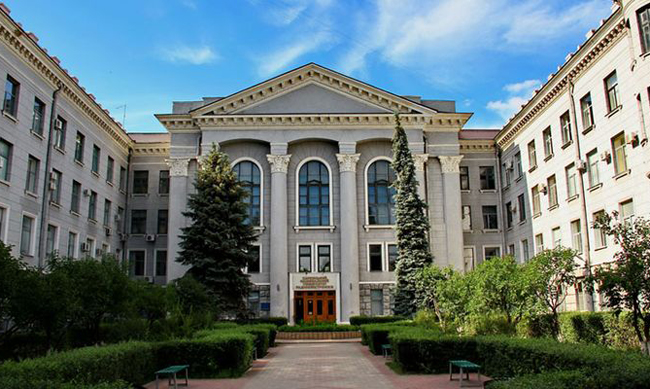Kharkiv National University of Radio Electronics
Kharkiv National University of Radio Electronics (Харківський національний університет радіоелектроніки; Kharkivskyi natsionalnyi universytet radioelektroniky; or ХНУРЕ; KhNURE). An institution of higher learning in Kharkiv which provides education in information technology, radio engineering, and electronics. It was founded in 1930 as Kharkiv Institute of Construction Engineering on the basis of the construction faculty of Kharkiv Polytechnical Institute and the architecture faculty of Kharkiv Art Institute. Among its founders was the famous Kharkiv architect Oleksii Beketov. In 1934 it incorporated Kharkiv Geodesic Institute and the Research Institute of Geodesy and Cartography. On the eve of the Second Word War the institute had four faculties: architecture; construction; sanitary engineering; and geodesy. In 1944 the institute was considerably reorganized and renamed to Kharkiv Mining Institute of the Coal Industry of the USSR (after 1947: Kharkiv Mining Institute of the Ministry of Higher Education of the USSR); it was actively involved in the rebuilding of coal mines in the Donets Basin. It had four faculties: mining; mining construction; mining and electromechanics; and industrial transport. In 1957 Kharkiv Mining Institute became the first institute in the USSR to begin training specialists in the automation of mining. The faculty conducted a pioneering research on the new methods of automation and telemechanics in the coal mines. The institute was renamed once again in 1962 to Kharkiv Institute of Mining Machine Building, Automatics, and Computer Engineering and again in 1966 to Kharkiv Institute of Radio Electronics. It had six faculties: automatics; computer engineering; radio engineering; radio physics; electronics; and mining machine building. In 1982 it was named after academician Mykhailo Yanhel. The institute’s faculty combined teaching with the cutting-edge research. Among the biggest achievements of the institute’s scholars in the 1980s and 1990s was the creation of the unique highly sensitive computerized equipment complex MARS (Meteor Automated Radar Station), and the compilation of an electronic orbital catalogue of 250,000 radio meteoroids (1992–8). The pioneering astronomy-based scientific school of the Meteorological Radar Ranging was headed by Professor Borys Kashcheiev. One of the small planets was later named after him; another, after Kharkiv National University of Radio Electronics. Kharkiv Institute of Radio Electronics was transformed into Kharkiv State Technical University of Radio Electronics in 1993. In 2001 the university was granted a national university status and assumed its current name.
KhNURE has seven faculties: computer science; computer engineering and administration; information and analytical technology and management; information radio technology and technical information protection; infocommunications; automatics and computer technology; and electronic and biomedical engineering. KhNURE also has a number of research laboratories and centers, among them laboratory of photonics, laboratory of hardware and software design and testing, laboratory of contemporary information technology ‘Akademiia Microsoft,’ laboratory ‘Business-incubator,’ center for remote learning technologies, center for information systems and technologies, and center for gender equity. The university campus includes 10 study and research buildings and 8 dormitories. As of 2021 the student enrollment was circa 7,000, including 600 foreign students. KhNURE’s research library includes 730,000 copies of books and more than 19,500 electronic documents.
KhNURE has been consistently ranked among the best universities in Ukraine. In 2020 it was ranked ninth in the independent academic ranking Top 200 Ukraine. KhNURE has been among a handful of Ukrainian universities to have appeared in the world’s most prestigious academic rankings. For instance, Times Higher Education Ranking in 2021 included KhNURE (ranked 801st) among only two Ukrainian universities that were listed in this prestigious ranking (another being Lviv National University ranked 1001st). In 2020 KhNURE was ranked in the group 251–300 in the QS EECA ranking that featured top universities in Emerging Europe & Central Asia.
KhNURE publishes a number of scholarly periodicals, including Bionika intelekta (93 vols, 1967–); Radioelektronika ta informatyka (86 vols, 1997–); Prykladna radioelektronika (17 vols, 2002–18); Radiotekhika (203 vols, 1965–); Problemy telekomunikatsii (26 vols, 2010–); and others.
BIBLIOGRAPHY
Bondarenko, M. et al. Kharkivs'kyi natsional'nyi universytet radioelektroniky (Kharkiv, 2010)
KhNURE official website: https://nure.ua/
Serhiy Bilenky
[This article was written in 2021.]
